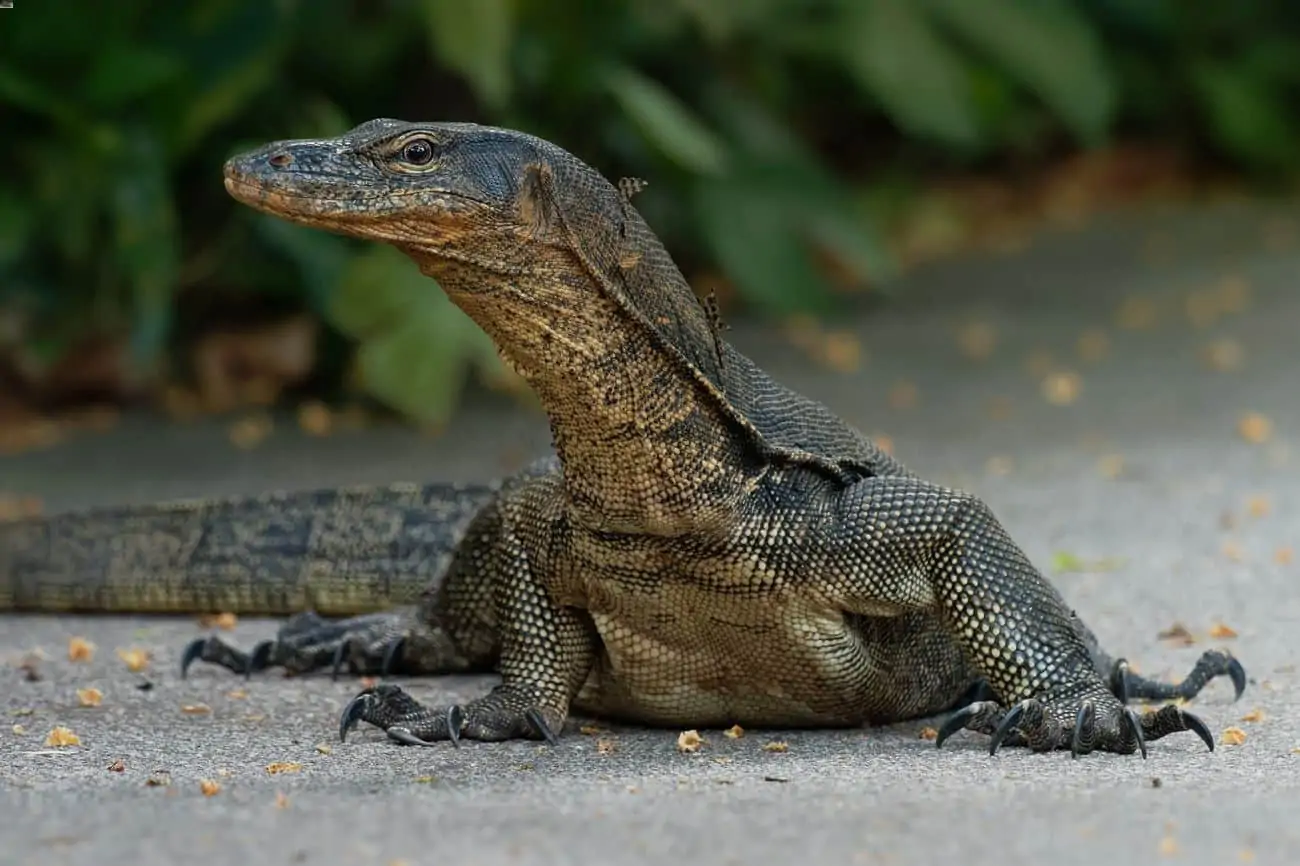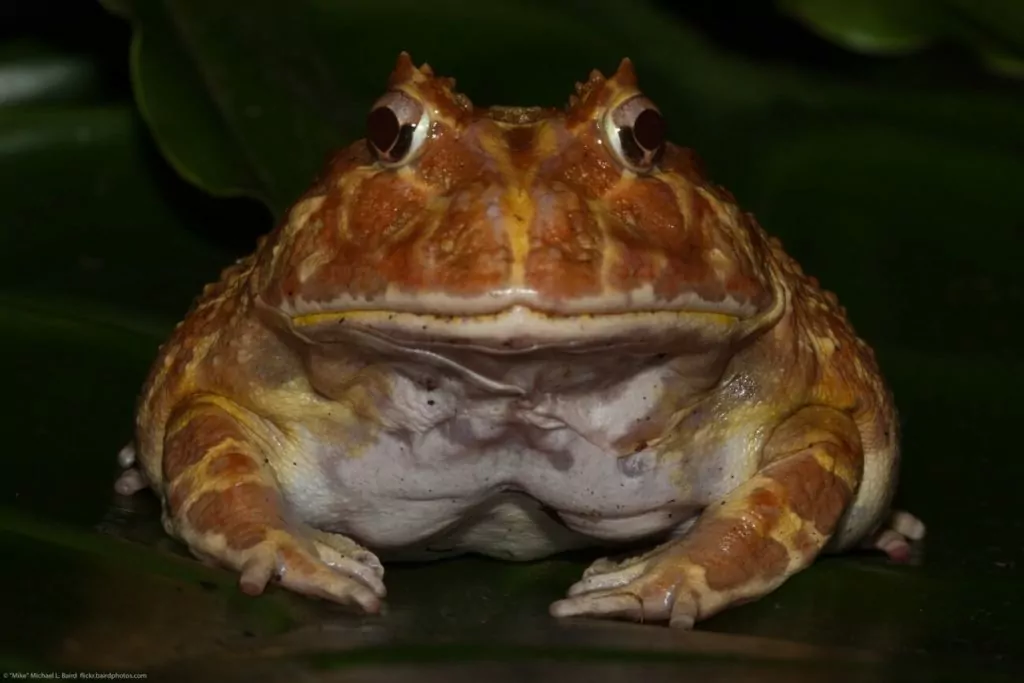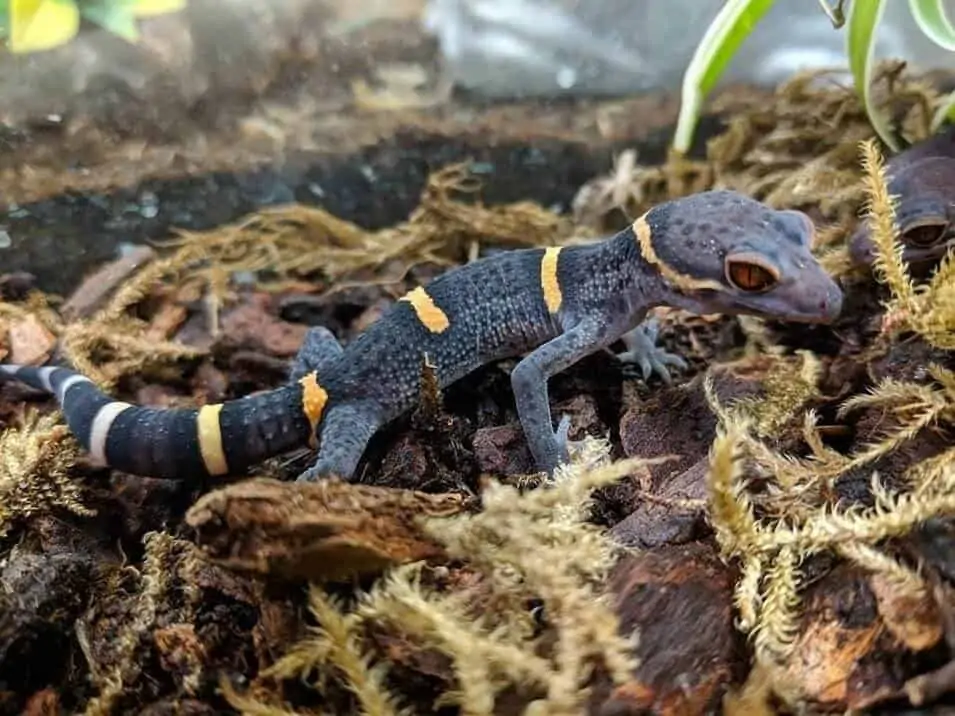Asian water monitors are a fascinating reptile that have earned plenty of respect and interest from humans over the years. These massive lizards are no joke!
And if you’re one of the bold reptile-lovers who is interested in owning this monitor as a pet, you’ve come to the right place. Since you have plenty of work ahead of you, we wanted to arm you with all the right information to help make the process easier.
This guide covers all the facts you need to know about the Asian water monitor, and how to care for them.
Table of Contents
Species Summary
The Asian water monitor (Varanus salvator) is also known as the Sumatran water monitor. In the wild, this water monitor can be found in the mangrove swamps of Southeast Asian countries like Sri Lanka, Malaysia, Indonesia and India.
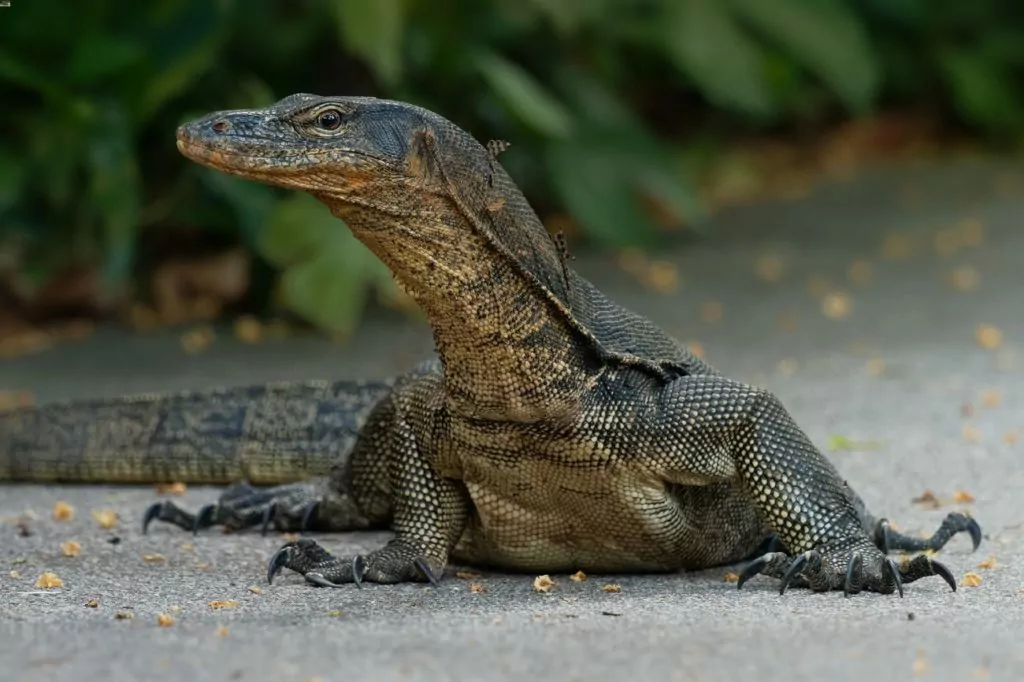
These scavenger lizards are considered to be extremely intelligent and curious and are highly prized by reptile enthusiasts.
Expert Tip: Due to their size, weight, temperament and lifespan, they require a very large enclosure space, specific care knowledge and a desire to form a long-term commitment. The Asian water monitor is not easy to care for and requires very advanced reptile-care knowledge.
Appearance & Colors
The skin color of the Asian water monitor ranges from dark brown to black, and they have beautiful yellow dots that run the whole length of the body.
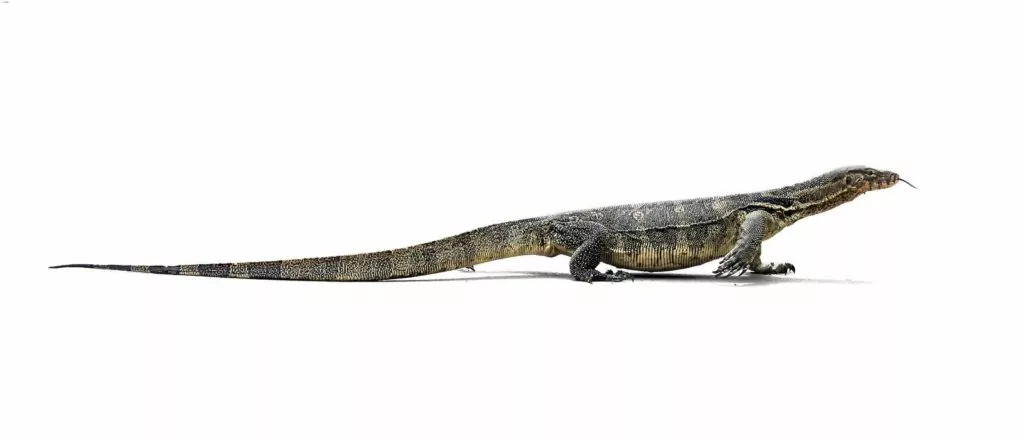
These lizards have the characteristic monitor body that features a long neck and snout, serrated teeth, sharp claws and almond-shaped eyes. A long, muscular tail is also typical for a monitor.
Asian water monitors also have durable, scaly skin that covers their whole body. This serves as an effective defense mechanism.
Asian Water Monitor Size
The average Asian water monitor size is five to eight feet in length for adult males, and four to size feet for adult females. This measurement includes their tail, which makes up a significant portion of their size.
After the Komodo dragon and the crocodile monitor, the Asian water monitor is the third longest lizard in the world. At maturity, this lizard can weigh as much as 150 pounds!
Expert Tip: Water monitor hatchlings are around 10 inches at birth, and they will grow several feet in the first year.
Lifespan
The lifespan of an Asian water monitor is around 15 years. With good care and a healthy diet and environment, these lizards can potentially live for 20 years or more.
One of the main reasons why these lizards may suffer a shorter lifespan in captivity is that owners aren’t truly prepared for the kind of care they require. Always make sure you have an accurate picture of what needs to be done before purchasing one!
Asian Water Monitor Care
Asian water monitor care can be quite difficult and time consuming. There’s no other way to say it.
Due to its sheer size and weight, this monitor requires a massive enclosure that you will need to build yourself. This enclosure will need to include plenty of climbing areas, places to hide and items to keep your lizard stimulated.
Since these lizards love to be in the water, you will also need to include a very large DIY water source.
Other requirements include a special diet, specific gradient lighting and a consistent humidity level.
Expert Tip: In addition to the above points, you should really think about the fact that you will be caring for this lizard for up to 25 years. Many people get these monitors as babies, and are not prepared to care for them once they begin to really grow.
Read the following sections to learn all the details about proper Asian water monitor care.
Enclosure Size & Dimensions
If you are going to own an Asian monitor lizard, all previous expectations of what enclosures reptiles need has to be put aside. The housing for this pet lizard is likely nothing you’ve ever dealt with.
The massive size of the Asian water monitor is going to be your biggest challenge when deciding on the type of enclosure you are going to build.
Hatchlings should be started off in a 40 gallon 36″x18″x16″ tank. Within a year, they are already going to need a minimum of a 8’x4’x6′ enclosure.
Expert Tip: As you can see, Asian water monitors grow very quickly, so you need to plan for this well in advance.
After your sweet hatchling gets to the adult stage, you are going to need to create a very large living space. It should be at least a foot and a half longer than the monitor, but this is just a minimum suggestion.
These lizards require lots of space to climb, bask and explore, so you should try to build as big of an enclosure as you have the space for.
Asian water monitors should always have their own enclosure unless you are trying to have them mate. These smart reptiles are not going to want to share their space with others!
Habitat Setup
What goes into the enclosure is just as important as the size of the space. Asian water monitors are very intelligent and active reptiles, so your enclosure should contain lots of things that are going to create both physical and mental stimulation.
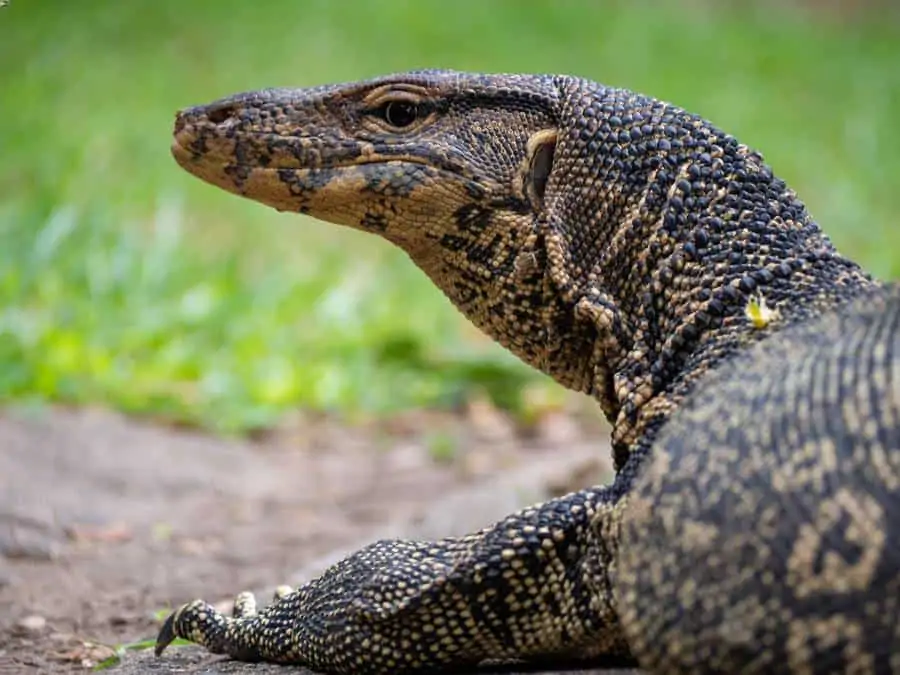
These monitors need lots of areas where they can bask or climb. Basking is required for proper digestion, and climbing provides exercise and stimulation. Large logs, branches and a variety of shelves can be used. When you are designing this part of your enclosure, make sure to give them lots of vertical space.
Another important addition to your monitor enclosure is a hide box. This is a place where they can cool off, feel safe and just chill out. It can also serve as an area with a little extra humidity.
You’re also going to want to add a large water area to the enclosure, but we’ll be discussing this in more detail later on in the care sheet.
As far as a substrate goes, it doesn’t have to be anything fancy. Good, clean dirt is usually enough. You can also add orchid bark or cypress mulch. The idea is to give your monitor a nice place to burrow.
Temperature & Lighting
Like every other aspect of Asian water monitor care, the lighting and temperature in the enclosure is very specific and geared towards advanced knowledge of reptile husbandry.
The temperature gradient within the enclosure is extremely important. You’ll be able to know if you’ve set it up correctly because your monitor will demonstrate a consistent basking and roaming pattern.
The ambient temperature within the enclosure should remain in the mid 80’s (Fahrenheit obviously).
On the other side, the basking area needs to be kept at a rather toasty 125 to 140 degrees Fahrenheit. This basking area is very important for your monitor’s successful digestion.
We highly suggest using multiple flood lights to provide the heating of your monitor’s enclosure. Depending on the size and design of the set up, you should position these lights to create maximum basking areas as well as areas for cooling down. Always make sure that the lights are not burning your monitor’s skin.
Expert Tip: The lighting schedule for your Asian water monitor should be a 12 hour on, 12 hour off routine. As far as UVB light goes, these lizards generally don’t require extra UVB. You can add a UVB bulb to your enclosure, but Asian water monitors usually get all the calcium and Vitamin D3 they need from their prey.
Humidity
Keeping the humidity at the proper level can be a bit tricky (especially in such a large enclosure). You’ll need to rely on an accurate hygrometer to let you know if you’re in the proper range.
The humidity level in their habitat should stay between 60 and 70 percent. If the humidity level gets too high in the enclosure, your monitor can become susceptible to scale and skin infections (more on that later).
Setting up a large water reservoir is going to be a key element for maintaining humidity levels. Misting the enclosure and placing peat moss in their hide spot helps as well.
Water
Providing plenty of clean, fresh water is absolutely essential for the health and happiness of your monitor. They love to soak in water, and they need enough to be able to fully submerge themselves.
Two issues arise when it comes to the water set up. Since Asian water monitors can grow to be eight feet in length, you’re going to need to create a very large water space.
The second is that monitors regularly defecate in their water. This means that at least twice a day, you are going to need to empty the water reservoir and fill it again with clean water.
Expert Tip: Having some type of drainage system can help, but the area still needs to be scrubbed and kept scrupulously clean. This is another reason to think very carefully before deciding to care for an Asian water monitor, because there’s no way around this!
A large plastic tub can be used as a water reservoir, and it’s great if you can sort of dig a spot for it in the substrate of the enclosure.
If you are thinking of putting in a filtration system, it’s important to avoid getting one with an overly strong intake. Your monitor can get sucked into it and get seriously injured.
Food & Diet
Asian water monitors are scavengers with absolutely huge appetites. In fact, they will eat whenever they get the chance. For this reason, you will have to carefully ration their food, or they may become obese.
If you have a hatchling, it is going to need to eat daily or every other day for a year or so. At this point in your monitor’s life, good nutrition is critical due to its rapid growth rate. Hatchlings are insectivores and can have gut loaded crickets and roaches.
As a monitor gets bigger, it stops being totally insectivorous, and it will enjoy trying whole prey items such as rodents, fish and poultry. These yearlings can be fed three to four times a week.
Adult Asian water monitors only need to be fed 2-3 times per week. Some food items to give them include canned insects, chicks, mice, ducklings, hard-boiled eggs or chicken organ meats. Since they are scavengers, it’s perfectly fine to give them pre-killed prey.
Expert Tip: Because monitors need heat to activate digestive enzymes, you will need to make sure that their basking area is at the right temperature (you can find the necessary details in an earlier section).
Potential Health Issues
Despite their hardy appearance, the Asian water monitor can fall victim to a number of different health issues. An informed pet owner is a responsible one, and we know that you’re going to want to give your monitor the best possible care and attention.
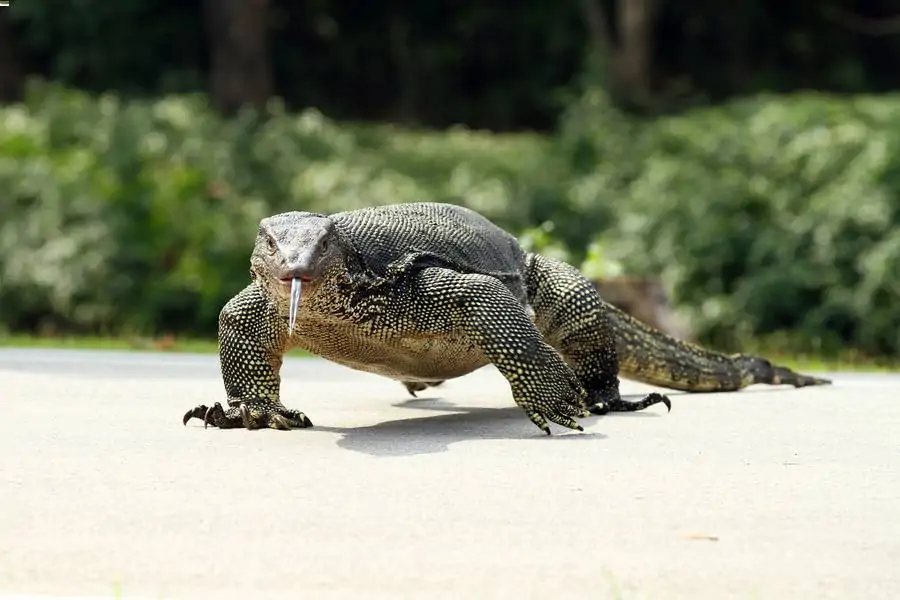
Let’s take a look at some of these health issues:
Digestive issues: Asian water monitors are prone to food impaction and constipation. They need a certain basking temperature to be able to activate their digestive enzymes. If the basking area is not hot enough, their food will not be digested completely, and this can lead to a serious impaction.
Burns: This is another potentially serious problem for these monitors that many owners don’t consider. If the basking lights in the enclosure are not placed properly, your monitor can get some pretty bad burns. This issue is easily prevented by ensuring a safe set up.
Respiratory infections: If the enclosure is too damp or cold, a monitor can get a respiratory infection. Symptoms include excess mucus, lethargy and open mouthed breathing.
Bacterial and fungal infections: An unclean enclosure or a stressful environment will make your Asian water monitor more susceptible to these kinds of infections.
Behavior & Temperament
Many monitor owners say that this lizard is friendly and happy to have human company. This claim has to be looked at in perspective because the Asian water monitor will never be a pet that enjoys a lot of handling (more on that later).
In fact, caution needs to be taken if you do try to handle your monitor. Asian water monitors will bite, and their serrated teeth can create a very nasty, very deep and sometimes toxic wound!
Asian water monitors are very intelligent and curious creatures that enjoy being given the space that will allow them to live as natural a life as possible.
Being diurnal animals, you will notice that your monitor is most active from dawn to late afternoon hours.
Handling Them
Our advice about handling your Asian water monitor is to not handle it very much at all. If you are determined to have a monitor that you can handle, then we suggest getting one that is very young (or another species entirely).
With patience, you may be able to get your monitor to tolerate some handling. However, you still need to exercise caution even if your monitor is very used to you.
Never attempt to handle an adult any more than is necessary. A bite from an eight foot, 150 monitor is going to be potentially very serious.
The best thing to do is to create a sense of respect between you and your pet. They are active, smart lizards that are best enjoyed through observation.
Conclusion
Asian water monitor care is not for everyone. These large reptiles require a lot of work and effort to be kept in captivity.
But if you’re committed, owning one of these lizards can be incredibly rewarding. Not only that, but their long lifespan will allow you to form quite a bond!
Let us know if you have any questions that weren’t covered in this care sheet. We tried to include as many actionable tips and facts as possible, but we’re open to adding more if requested!

